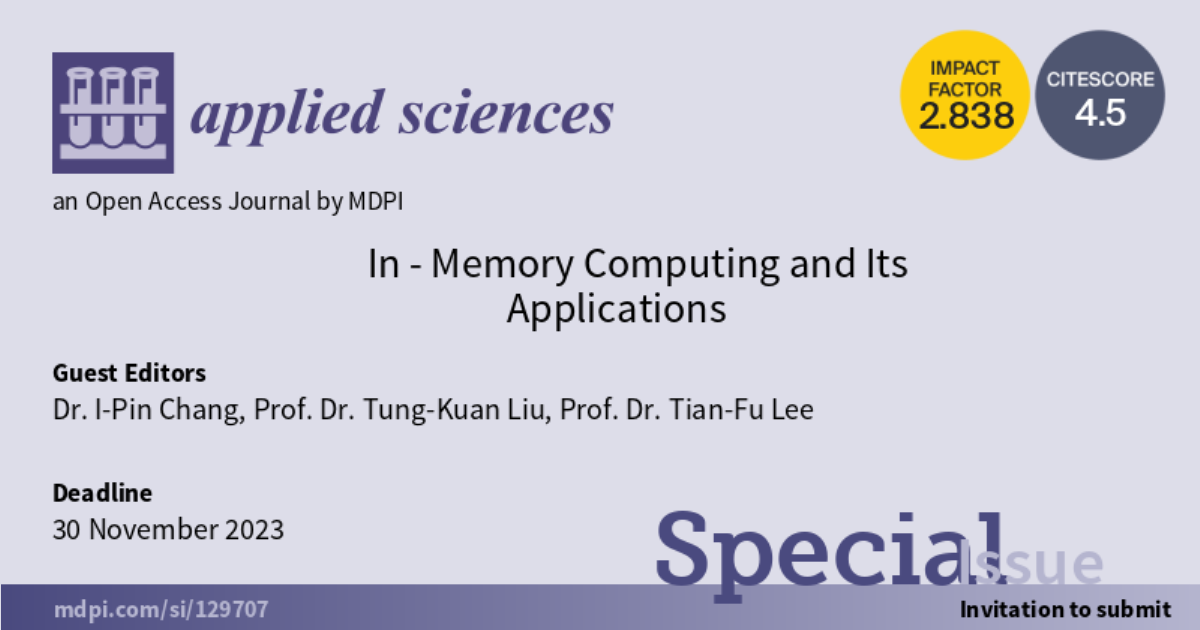In-Memory Computing and Its Applications
A special issue of Applied Sciences (ISSN 2076-3417). This special issue belongs to the section "Computing and Artificial Intelligence".
Deadline for manuscript submissions: closed (30 November 2023) | Viewed by 3018

Special Issue Editors
Interests: database management system; system development; information security; statistical analysis
Interests: artificial intelligence; multi-object optimization technology; airline crew rostering and production scheduling technology; supply chain management technology
Interests: cryptography; medical information security; wireless network; network security; sensor networks and HIPAA privacy/security regulations
Special Issues, Collections and Topics in MDPI journals
Special Issue Information
Dear Colleagues,
In-memory computing refers to computing systems where the memory is placed as close as possible to the processing systems. In-memory computing, in its many forms, refers to the use of direct memory instead of disks for the purposes of storage and computation. An architecture based on in-memory computing has numerous benefits. This Special Issue seeks novel contributions in the form of high-quality, unpublished, and in-depth fundamental research that aims to address the existing technical problems and challenges in the domain of in-memory computing and its applications.
The goal of this Special Issue is to explore the existing architectures, models, and techniques and to integrate new technologies, focusing on performance evaluation and comparison with existing solutions in the field of in-memory computing and its applications. This Special Issue encourages both theoretical and experimental studies of in-memory computing and its applications. Furthermore, high-quality review and survey papers are welcome. Academic researchers, developers and industry practitioners are invited to contribute papers to this Special Issue. Topics of interest include (but are not limited to) one or more of the following topics:
- In-memory data management
- In-memory processing with multi-cores/many-cores
- Programming framework and compiling skills for in-memory computing
- In-memory computing applications and architectures;
- System software support for in-memory computing
- Big data applications with in-memory computing
- In-memory computing for deep learning and neural networks
- Security, privacy, and trust issues for in-memory computing, etc.
Dr. I-Pin Chang
Prof. Dr. Tung-Kuan Liu
Dr. Tian-Fu Lee
Guest Editors
Manuscript Submission Information
Manuscripts should be submitted online at www.mdpi.com by registering and logging in to this website. Once you are registered, click here to go to the submission form. Manuscripts can be submitted until the deadline. All submissions that pass pre-check are peer-reviewed. Accepted papers will be published continuously in the journal (as soon as accepted) and will be listed together on the special issue website. Research articles, review articles as well as short communications are invited. For planned papers, a title and short abstract (about 100 words) can be sent to the Editorial Office for announcement on this website.
Submitted manuscripts should not have been published previously, nor be under consideration for publication elsewhere (except conference proceedings papers). All manuscripts are thoroughly refereed through a single-blind peer-review process. A guide for authors and other relevant information for submission of manuscripts is available on the Instructions for Authors page. Applied Sciences is an international peer-reviewed open access semimonthly journal published by MDPI.
Please visit the Instructions for Authors page before submitting a manuscript. The Article Processing Charge (APC) for publication in this open access journal is 2400 CHF (Swiss Francs). Submitted papers should be well formatted and use good English. Authors may use MDPI's English editing service prior to publication or during author revisions.
Keywords
- big data
- security
- in-memory computing
- in-memory computing architectures
- in-memory computing applications
- in-memory data management
- deep learning
- neural networks






